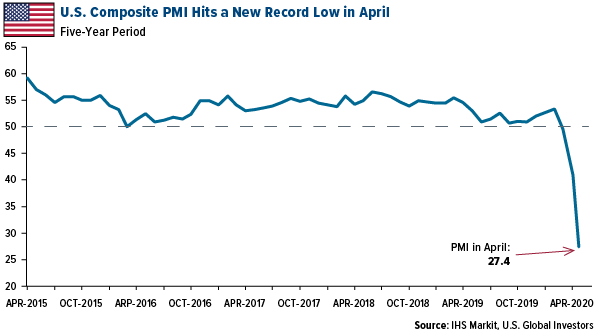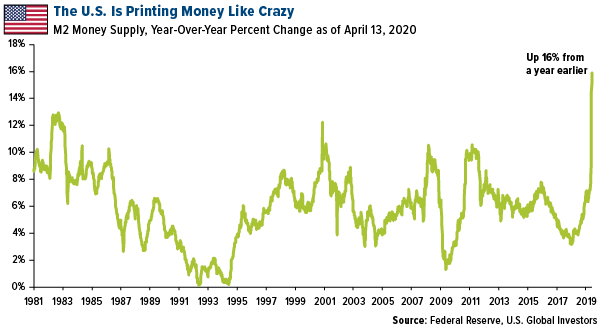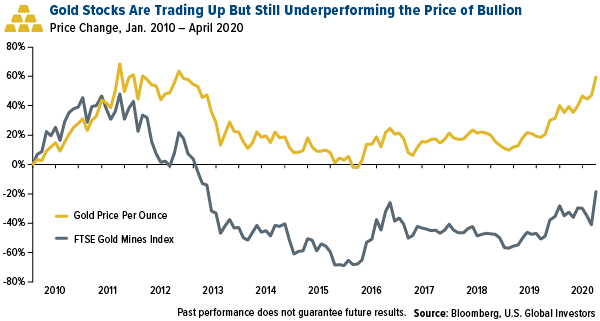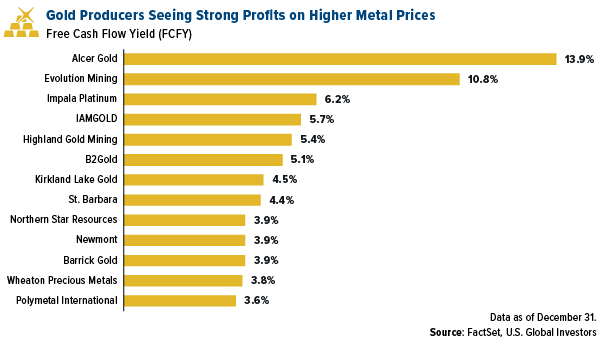
Physical gold continued to catch a bid last week, trading above $1,760 an ounce, on a host of head-spinning economic news, from millions more Americans filing jobless claims to record money-printing to negative oil prices.
The national average price for a gallon of gasoline fell further to $1.78 on Friday, down more than $1 a gallon from a year ago. But the lowest price in the country may belong to a Shell station in Francis Creek, Wisconsin, which is reportedly selling (giving away?) gas for $0.75 per gallon, according to GasBuddy’s Patrick De Haan.
The seriousness of the coronavirus-fueled recession is reflected in April’s preliminary health reading of America’s manufacturing and service sector industries. The composite purchasing manager’s index (PMI) plunged to 27.4, a new series low, as companies were shuttered and millions of non-essential workers were furloughed or laid off. A staggering 26.4 million people, or about 15 percent of the U.S. workforce, have now lost their jobs since mid-March due to the Great Lockdown.
“The scale of the fall in the PMI adds to signs that the second quarter will see an historically dramatic contraction of the economy, and will add to worries about the ultimate cost of the fight against the pandemic,” writes Chris Williamson, chief business economist at IHS Markit, which produces the monthly business survey.
Some U.S. states are slowly starting to reopen their economies, and I’m eager to see what effect this might have on May’s PMI. If it turns up, it could indicate the bottom is behind us. The most aggressive of any state right now appears to be Georgia, whose governor, Brian Kemp, has come under fire by even President Donald Trump for allowing high-risk businesses such as gyms and hair salons to open their doors to customers. The southern state processed more unemployment claims in the last week of March than it did in all of 2019, according to CityLab.
Fire Up the Money Printers…
Bloomberg reports that in the month of March, central banks in Group of Seven countries purchased some $1.4 trillion in financial assets in an effort to soften the blow of the pandemic. That’s nearly five times the previous monthly record set in April 2009, when the world was dealing with what was then the worst crisis since the Great Depression.
Meanwhile, world governments have unleashed a combined $8 trillion in fiscal stimulus, with more on the way. Last week alone, the U.S. House of Representatives approved, and the president signed, an additional $464 billion in relief for small businesses that have been impacted by the economic downturn, as well as funding for hospitals and testing.
For fiscal year 2020, the federal budget deficit could hit an incredible $3.7 trillion, the Congressional Budget Office (CBO) said on Friday. That would be its largest size as a share of the U.S. economy since World War II.
Right now the U.S. is printing money on a scale we’ve never seen. The amount of M2 money supply—which includes cash and “near money” such as savings deposits, money market securities and mutual funds—has raced up 16 percent compared to the same time a year ago. That may not seem like much, until you put it in an historical context and see just how significant the ramp-up really is.
Physical Gold Is Glittering, but Don’t Overlook Gold Mining Stocks
All of this is constructive for the price of gold, which I believe is on a path to exceed its previous record of $1,900 an ounce. Analysts at Bank of America now see the precious metal touching $3,000 within the next 18 months.
And if that happens, just wait and see what gold mining companies do.
Shares of senior producers, as measured by the FTSE Gold Mines Index, are up close to 20 percent for the year, but for the 10-year period they still trail the metal’s spot price performance. I believe this makes the group an attractive investment opportunity, especially now that gold mining is one of the few industries generating strong revenues and free cash flow on higher metal prices.
Think about it: With more than 26 million people applying for unemployment benefits in the past month and a half, many S&P 500 stocks’ revenue will dry up. Gold stocks should shine, by comparison, and I predict we’ll see new buyers who focus on companies with free cash flow, one of the best metrics of profitability.
Take a look below. What you see are the most profitable precious metal mining stocks with a market cap of $1 billion or more, based on free cash flow yield (FCFY). This is a metric that basically tells you how much cash the business is generating after taxes relative to how much it costs to operate. The lower the number, the less cash it’s making. The higher the number, the more cash it’s making.
Included in this list are highly liquid, mega-cap producers like Barrick (3.9 percent FCFY) and Newmont (also 3.9 percent), smaller firms such as the Russian Highland Gold Mining (5.4 percent) and everything in between. One royalty company, Wheaton Precious Metals (3.8 percent), is also represented.
Topping the list is intermediate miner Alacer Gold, which released positive initial drill results last week at its Copper Hill project in Turkey. The Denver-based producer reported “impressive grades” at the site, with the copper close to the surface and “very low” in contaminates.
Something I ought to point out is that the data above is as of December 31, as companies have not yet reported for the first quarter of 2020. For comparison’s sake, the S&P 500’s average FCFY for the same period was 5.6 percent. Even before the market tanked and gold began to surge, a few of the metal producers were already outperforming S&P 500 stocks in cash generation.
Keep your eyes on mining stock earnings in the coming days and weeks. Time will tell, but I expect to see that many generated healthy levels of free cash flow in the March quarter, which should help attract investors who up until this point may have been sitting on the sidelines.
Never miss a story! Subscribe to our award-winning Investor Alert today by clicking here!
All opinions expressed and data provided are subject to change without notice. Some of these opinions may not be appropriate to every investor. By clicking the link(s) above, you will be directed to a third-party website(s). U.S. Global Investors does not endorse all information supplied by this/these website(s) and is not responsible for its/their content.
Free cash flow (FCF) represents the cash a company generates after accounting for cash outflows to support operations and maintain its capital assets.
The S&P 500 Stock Index is a widely recognized capitalization-weighted index of 500 common stock prices in U.S. companies. The FTSE Gold Mines Index Series encompasses all gold mining companies that have a sustainable and attributable gold production of at least 300,000 ounces a year, and that derive 75% or more of their revenue from mined gold.
The Purchasing Manager’s Index is an indicator of the economic health of the manufacturing sector. The PMI index is based on five major indicators: new orders, inventory levels, production, supplier deliveries and the employment environment.
Holdings may change daily. Holdings are reported as of the most recent quarter-end. The following securities mentioned in the article were held by one or more accounts managed by U.S. Global Investors as of 3/31/2020: Polymetal International PLC, Newmont Corp., Alacer Gold Corp., Evolution Mining Ltd., Impala Platinum Holdings Ltd., IAMGOLD Corp., Highland Gold Mining Ltd., B2Gold Corp., Kirkland Lake Gold Ltd., St Barbara Ltd., Northern Star Resources Ltd., Barrick Gold Corp., Wheaton Precious Metals Corp.




